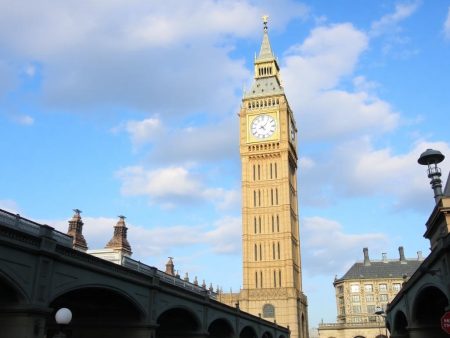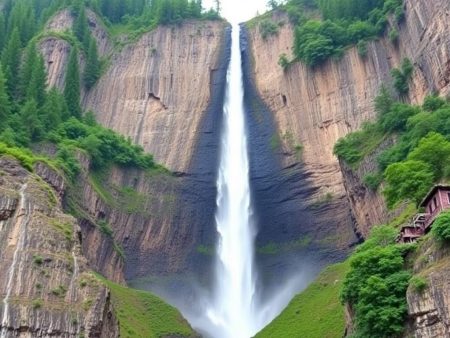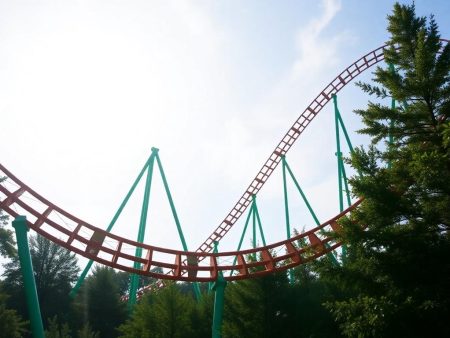L'horizon de Seattle est un mélange époustouflant de design moderne et de merveilles architecturales, mais une structure se démarque littéralement des autres. Le plus haut bâtiment de la ville n'est pas seulement une prouesse d'ingénierie ; c'est un symbole d'innovation et d'ambition, dominant les rues animées en contrebas.
Ce gratte-ciel emblématique est devenu un élément déterminant de l'identité de Seattle, attirant visiteurs et habitants
Découvrez le Columbia Center : le plus haut bâtiment de l'emblématique skyline de Seattle
L'horizon de Seattle est un mélange époustouflant de design moderne et de merveilles architecturales, mais une structure se démarque littéralement des autres. Le plus haut bâtiment de la ville n'est pas seulement une prouesse d'ingénierie ; c'est un symbole d'innovation et d'ambition, dominant les rues animées en contrebas.
Convertissez la hauteur des personnes, bâtiments, montagnes et monuments les plus grands en m, pieds et pouces pour comparer
0' 0" est égal à 0,0 cm ou 0,00 m.
Ce gratte-ciel emblématique est devenu un élément déterminant de l'identité de Seattle, attirant les visiteurs et les habitants venus s'émerveiller devant sa grandeur. Que vous soyez un passionné d'architecture ou simplement curieux de savoir ce qui rend ce bâtiment si spécial, son histoire est aussi fascinante que sa hauteur.
Aperçu du plus haut bâtiment de Seattle
Le Columbia Center est le plus haut bâtiment de Seattle, mesurant 280 mètres de haut. Achevé en 1985, il comprend 76 étages au-dessus du sol et deux niveaux souterrains supplémentaires. Ce gratte-ciel est situé dans le quartier central des affaires de la ville, ce qui en fait un élément emblématique de l'horizon de Seattle.
Conçu par l'architecte Chester L. Lindsey, le Columbia Center intègre des éléments architecturaux postmodernes. Sa façade associe verre noir réfléchissant et acier, créant une structure à plusieurs niveaux distincte. Cette conception optimise à la fois l'attrait esthétique et l'efficacité structurelle.
Le bâtiment abrite un mélange d'espaces de bureaux, de magasins de détail et de restaurants. Les attractions publiques comprennent l'observatoire Sky View, situé au 73e étage avec une vue panoramique sur le mont Rainier, le Puget Sound et les montagnes olympiques.
Conception et caractéristiques architecturales
Le Columbia Center incarne l'architecture moderne, alliant esthétique et fonctionnalité. Son design reflète des concepts innovants qui mettent en valeur ses éléments extérieurs et intérieurs.
Conception extérieure
L'extérieur du bâtiment met en valeur son style postmoderne avec des matériaux en acier et en verre réfléchissant noir élégant. La structure à plusieurs niveaux se rétrécit doucement à mesure qu'elle s'élève, créant un contraste visuel avec l'horizon de Seattle. Des retraits distinctifs de chaque côté améliorent la stabilité structurelle et réduisent la résistance au vent. La façade intègre des caractéristiques avancées d'efficacité thermique, gardant les intérieurs isolés tout en réduisant la consommation d'énergie. Conçue pour maximiser l'impact visuel, la surface sombre de la structure reflète fréquemment les couleurs changeantes du ciel, ajoutant un intérêt visuel dynamique.
Aménagement intérieur et utilisation
L'intérieur privilégie la flexibilité et l'utilité tout en conservant une esthétique élégante et professionnelle. Les espaces de bureaux, les points de vente et les salles à manger sont répartis sur 76 étages, offrant un mélange fonctionnel de services. L'observatoire Sky View au 73e étage, qui s'étend sur 360 degrés, offre des vues inégalées et constitue une attraction publique de premier ordre. De grandes fenêtres assurent une lumière naturelle abondante dans les espaces, améliorant l'efficacité énergétique et le confort des occupants. Des ascenseurs avancés, dotés de mécanismes à grande vitesse, assurent un transport vertical fluide pour les locataires et les visiteurs. Les deux niveaux souterrains du bâtiment abritent des installations de stockage et de service supplémentaires, optimisant l'utilisation de l'espace.
Importance historique
Le Columbia Center occupe une place cruciale dans l'histoire de Seattle, symbolisant la croissance économique et l'évolution culturelle de la ville à la fin du XXe siècle. Sa présence imposante reflète le développement ambitieux de l'horizon de Seattle.
Calendrier de construction
La construction du Columbia Center a débuté en 1982 et s'est achevée en 1985. Pour ce projet, des milliers d'ouvriers ont collaboré pendant trois ans, mettant en œuvre des méthodes d'ingénierie avancées pour assurer la stabilité et la sécurité de la structure. La conception, dirigée par Chester L. Lindsey, a donné la priorité à la fois à la forme et à la fonctionnalité, en s'efforçant de refléter les ambitions progressistes de la ville.
Étapes clés
En 1985, le Columbia Center a ouvert ses portes, devenant le plus haut bâtiment de Seattle et du Nord-Ouest Pacifique. Il a dépassé la Smith Tower, qui détenait le record depuis 1914, marquant ainsi le début d'une nouvelle ère pour le paysage urbain de Seattle. L'observatoire Sky View a été ajouté en 1994, créant ainsi l'un des espaces publics les plus visités de la ville. En outre, le Columbia Center est resté un centre d'événements commerciaux et communautaires, consolidant ainsi son rôle dans les sphères culturelles et commerciales de Seattle.
Comparaisons avec d'autres immeubles de grande hauteur à Seattle
Seattle compte plusieurs gratte-ciels emblématiques, mais le Columbia Center reste le plus haut avec 282 mètres. Le deuxième plus haut bâtiment de la ville, le 1201 Third Avenue, culmine à 234 mètres et compte 55 étages, avec un design moderniste et une silhouette en gradins. Achevé en 1988, il est principalement utilisé pour des espaces de bureaux.
Le 901 Fifth Avenue, qui culmine à 165 mètres et compte 42 étages, occupe la troisième place. Construit en 1973, son design rectangulaire et épuré met l'accent sur la fonctionnalité plutôt que sur l'esthétique. La Smith Tower, gratte-ciel historique de Seattle achevé en 1914, mesure 147 mètres et compte 38 étages. Autrefois le plus haut bâtiment à l'ouest du fleuve Mississippi, il présente une architecture néoclassique et reste un monument populaire.
Bien que le Columbia Center domine en hauteur, chacune de ces structures ajoute des caractéristiques uniques à l'horizon de Seattle, du charme historique à l'efficacité moderniste.
Expérience et commodités pour les visiteurs
Le Columbia Center propose une combinaison d'attractions et d'équipements uniques qui s'adressent aussi bien aux visiteurs qu'aux professionnels. Ses caractéristiques modernes et ses espaces publics renforcent son attrait en tant que destination à Seattle.
Plateforme d'observation
L'observatoire Sky View, situé au 73e étage, offre une vue panoramique inégalée à 360 degrés. Les visiteurs peuvent admirer des monuments emblématiques tels que le mont Rainier, le Puget Sound, la Space Needle et les montagnes Cascade et Olympic. Des télescopes puissants et des bornes interactives offrent des perspectives détaillées, enrichissant l'expérience d'observation. L'accès payant garantit un environnement confortable et peu fréquenté pour les visiteurs, avec des options de visites de jour et de soirée pour apprécier l'évolution de l'horizon.
Options de restauration et de divertissement
Le Columbia Center abrite plusieurs restaurants, allant des cafés décontractés aux restaurants gastronomiques, proposant des cuisines diverses telles que des plats italiens, japonais et inspirés du nord-ouest du Pacifique. L'aire de restauration du bâtiment s'adresse aux visiteurs quotidiens et aux employés de bureau avec des sélections de service rapide. Les options de divertissement comprennent des événements publics occasionnels organisés dans le bâtiment, tels que des expositions d'art et des célébrations saisonnières. Combinant variété culinaire et activités engageantes, le centre crée une atmosphère dynamique pour les clients.
Durabilité et impact environnemental
Le Columbia Center intègre des caractéristiques de conception durables pour réduire son empreinte environnementale. La façade du bâtiment utilise du verre noir réfléchissant, qui minimise l'absorption de chaleur et réduit les besoins de refroidissement. Les systèmes CVC écoénergétiques optimisent encore davantage l'utilisation des ressources, garantissant une consommation d'énergie plus faible sans compromettre le confort intérieur.
La conservation de l'eau est une priorité grâce à des appareils à faible débit installés dans les toilettes et les cuisines. Ces appareils limitent la consommation d'eau tout en maintenant la fonctionnalité, conformément aux normes écologiques. De plus, la direction du bâtiment favorise la réduction des déchets en mettant en œuvre de solides programmes de recyclage dans l'ensemble de l'établissement.
L'éclairage naturel joue un rôle essentiel dans l'aménagement intérieur du bâtiment. De grandes fenêtres maximisent la pénétration de la lumière naturelle, réduisant ainsi le recours à l'éclairage artificiel. Cette approche contribue de manière significative à l'efficacité énergétique des espaces de bureaux et des espaces communs.
Les pratiques réutilisables s'étendent aux politiques opérationnelles. L'entretien courant comprend l'utilisation de produits de nettoyage non toxiques, garantissant des espaces plus sains pour les occupants et une pollution environnementale moindre. Dans l'ensemble, le Columbia Center est un exemple majeur de la manière dont le développement urbain peut concilier progrès et durabilité.
Conclusion
Le Columbia Center n'est pas seulement le plus haut bâtiment de Seattle ; il témoigne de l'innovation, de l'ambition et de l'évolution de l'identité de la ville. Son design remarquable, sa riche histoire et ses équipements modernes en font un élément remarquable du paysage urbain et un centre d'intérêt pour les habitants et les visiteurs. Qu'il soit admiré de loin ou vu de près, il continue de laisser une impression durable tout en façonnant l'héritage architectural et culturel de Seattle.
Questions fréquemment posées
Quel est le plus haut bâtiment de Seattle ?
Le plus haut bâtiment de Seattle est le Columbia Center, qui culmine à 280 mètres et compte 76 étages au-dessus du sol. Il est devenu un élément emblématique de l'horizon de Seattle depuis son achèvement en 1985.
Qu'est-ce qui rend le Columbia Center unique dans le paysage urbain de Seattle ?
Le Columbia Center présente un design postmoderne avec une structure à plusieurs niveaux et une façade en verre noir réfléchissant. Il allie attrait esthétique et efficacité structurelle tout en offrant une vue panoramique depuis son observatoire Sky View.
Qu'est-ce que l'observatoire Sky View du Columbia Center ?
L'observatoire Sky View est situé au 73e étage du Columbia Center. Il offre une vue panoramique à 360 degrés sur Seattle, notamment sur des monuments tels que le mont Rainier et le Puget Sound, grâce à des télescopes et des bornes interactives.
Qui a conçu le Columbia Center ?
Le Columbia Center a été conçu par l'architecte Chester L. Lindsey. Son style postmoderne met l'accent à la fois sur l'esthétique et la fonctionnalité, en mettant l'accent sur la durabilité et l'efficacité énergétique.
Quand le Columbia Center a-t-il été achevé ?
Le Columbia Center a été achevé en 1985, après trois ans de construction qui ont commencé en 1982. C'était le plus haut bâtiment de Seattle et du nord-ouest du Pacifique à l'époque.
Comment le Columbia Center se compare-t-il aux autres gratte-ciel de Seattle ?
Le Columbia Center est le plus haut bâtiment de Seattle avec 282 mètres, suivi du 1201 Third Avenue avec 234 mètres et du 901 Fifth Avenue avec 165 mètres. Ces bâtiments apportent une diversité de styles architecturaux à l'horizon.
De quels équipements les visiteurs peuvent-ils profiter au Columbia Center ?
Le Columbia Center offre une variété d'équipements, notamment des espaces de bureaux, des magasins de détail, l'observatoire Sky View, diverses options de restauration, une aire de restauration et des événements publics occasionnels.
Le Columbia Center est-il écologique ?
Oui, le Columbia Center comprend des caractéristiques durables telles que du verre à haut rendement thermique, des systèmes CVC écoénergétiques, des appareils à faible débit d'eau, des programmes de recyclage et l'utilisation de produits de nettoyage non toxiques.
À quelles vues les visiteurs peuvent-ils s'attendre depuis le Columbia Center ?
Depuis l'observatoire Sky View, les visiteurs peuvent profiter d'une vue imprenable sur le mont Rainier, le Puget Sound, les montagnes olympiques et l'horizon emblématique de la ville, agrémenté de télescopes et d'écrans interactifs.
Pourquoi le Columbia Center est-il important pour l’histoire de Seattle ?
Le Columbia Center symbolise la croissance économique et l'évolution culturelle de Seattle. Il est devenu le plus haut bâtiment à l'ouest du Mississippi en 1985, mettant en valeur l'ambition et l'innovation de la ville à la fin du XXe siècle.





